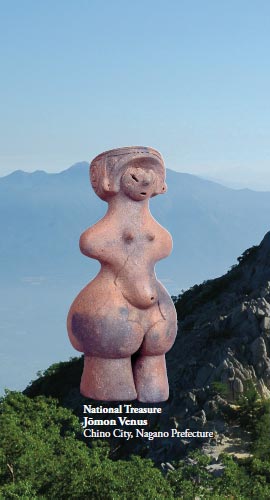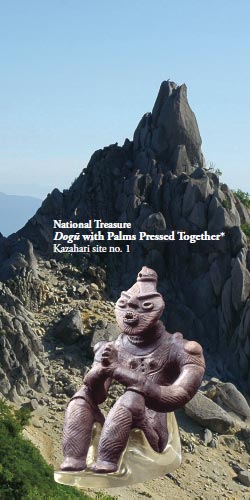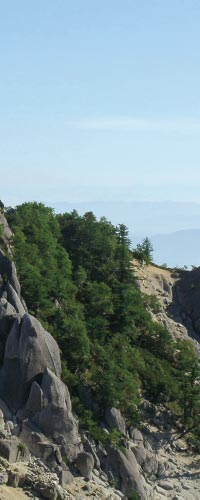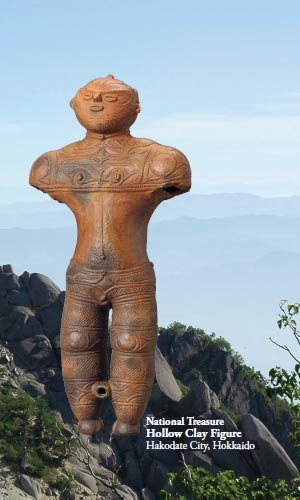




As the numbers of
dogū gradually increased, in some regions, they were
intentionally destroyed and were made to break easily from the
beginning. The fragments were scattered here and there, making it rare
to find all the pieces to reconstruct a figurine. Many clay statuettes
came to be made in the Chubu region, centering on the base of the
Yatsugatake mountain range, and the Hokuriku region, where the cultural
sphere of the mid-Jōmon period formed. Perhaps the reason most of these
images appear feminine with emphasized hips may have been related to
fertility and abundance. There are examples of dogū carrying a baby and
apparently in the midst of giving birth. Could these images have been
the object of worship or have played some other role?
The oldest extant stories in Japan, Kojiki (Record of Ancient Matters) and Nihon shoki (Chronicles of Japan), were compiled over 1500 years after the end of the Jōmon period. However, in the worldview of these chronicles is reflected the idea that the spirit of the Japanese began in the Jōmon period. One is the tale of Oogetsuhime in Kojiki, in which this deity could produce food from the holes she had all over her body. Once she tried to offer food to the god Susanoo, who happened to see her preparing the food and killed her on the spot. Then the seeds of the five grains appeared from her body. Perhaps it was believed that by breaking and burying the dogū, precious food supplies would be produced.
The oldest extant stories in Japan, Kojiki (Record of Ancient Matters) and Nihon shoki (Chronicles of Japan), were compiled over 1500 years after the end of the Jōmon period. However, in the worldview of these chronicles is reflected the idea that the spirit of the Japanese began in the Jōmon period. One is the tale of Oogetsuhime in Kojiki, in which this deity could produce food from the holes she had all over her body. Once she tried to offer food to the god Susanoo, who happened to see her preparing the food and killed her on the spot. Then the seeds of the five grains appeared from her body. Perhaps it was believed that by breaking and burying the dogū, precious food supplies would be produced.
However, there were also
dogū which were not destroyed. The National
Treasure Jōmon Venus was carefully buried in a hole in a central square
of a village. Since this open space once had ancestral graves, this
image may have been a burial accessory. Its heart-shaped face,
protruding belly, and enormous hips truly give it the appearance of an
earth mother. This outstanding sculpture makes us want to imagine that
it was an object of worship.
A cultural sphere, which spread across the Tohoku region and Hokkaido and centered on the periphery of Aomori, emerged after several thousand years in the late and final stages of the Jōmon period. Many figurines named Shakōki dogū (“spaceman” dogū) were produced in these areas and painted red or black in lacquer with colorful and complex motifs. During the more than 10,000 years of the Jōmon period, many different magnificent figures—including mountain-shaped dogū, horned owl dogū, dogū sitting with one knee drawn up, flat dogū, and dogū with asphalt in the eyes—were made all across Japan.
These clay figurines may have represented spirits, gods, or evil deities. Perhaps they were merely toys. This exhibition at MIHO MUSEUM presents approximately 320 works, featuring approximately 220 dogū from as far north as Hokkaido to as far south as Kyushu. Highlights include three National Treasures, twenty-one Important Cultural Properties, one Important Art Object, and twenty-eight locally designated works. We invite you to come and explore these sublime figurines, which stand at the roots of the Japanese spirit.
A cultural sphere, which spread across the Tohoku region and Hokkaido and centered on the periphery of Aomori, emerged after several thousand years in the late and final stages of the Jōmon period. Many figurines named Shakōki dogū (“spaceman” dogū) were produced in these areas and painted red or black in lacquer with colorful and complex motifs. During the more than 10,000 years of the Jōmon period, many different magnificent figures—including mountain-shaped dogū, horned owl dogū, dogū sitting with one knee drawn up, flat dogū, and dogū with asphalt in the eyes—were made all across Japan.
These clay figurines may have represented spirits, gods, or evil deities. Perhaps they were merely toys. This exhibition at MIHO MUSEUM presents approximately 320 works, featuring approximately 220 dogū from as far north as Hokkaido to as far south as Kyushu. Highlights include three National Treasures, twenty-one Important Cultural Properties, one Important Art Object, and twenty-eight locally designated works. We invite you to come and explore these sublime figurines, which stand at the roots of the Japanese spirit.

Dogū with Heart-shaped Face*
Tangible Cultural Property of Hitachinaka City
Hitachinaka City Archaeological Research Center
Tangible Cultural Property of Hitachinaka City
Hitachinaka City Archaeological Research Center
Exhibition dates for the National Treasures:
Jōmon Venus, 10/12
(Fri.)–12/9 (Sun.)
Dogū with Palms Pressed Together, 11/9 (Fri.)–12/9 (Sun.)
Hollow Clay Figure, 11/30 (Fri.)–12/9 (Sun.)
Dogū with Palms Pressed Together, 11/9 (Fri.)–12/9 (Sun.)
Hollow Clay Figure, 11/30 (Fri.)–12/9 (Sun.)